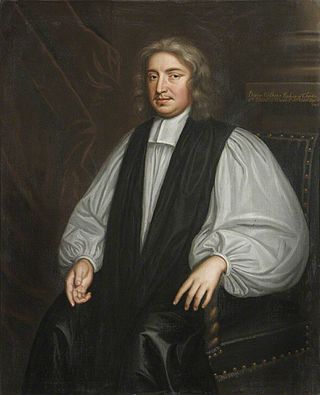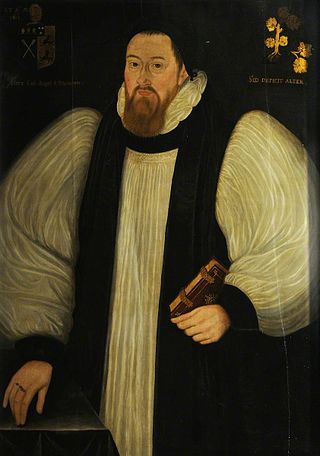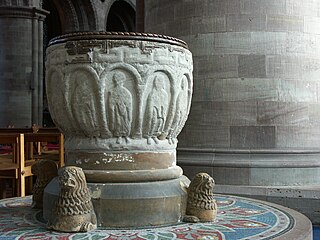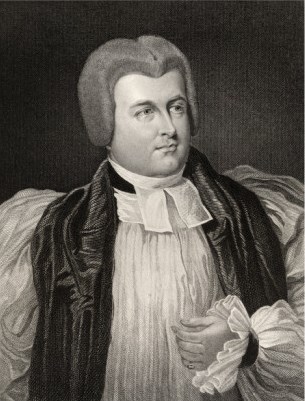Related Research Articles

Ealdred was Abbot of Tavistock, Bishop of Worcester, and Archbishop of York in early medieval England. He was related to a number of other ecclesiastics of the period. After becoming a monk at the monastery at Winchester, he was appointed Abbot of Tavistock Abbey in around 1027. In 1046 he was named to the Bishopric of Worcester. Ealdred, besides his episcopal duties, served Edward the Confessor, the King of England, as a diplomat and as a military leader. He worked to bring one of the king's relatives, Edward the Exile, back to England from Hungary to secure an heir for the childless king.

John Wilkins, was an Anglican clergyman, natural philosopher, and author, and was one of the founders of the Royal Society. He was Bishop of Chester from 1668 until his death.

Francis Godwin (1562–1633) was an English historian, science fiction author, divine, Bishop of Llandaff and of Hereford.
William de Vere was Bishop of Hereford and an Augustinian canon.

Arthur Lake was Bishop of Bath and Wells and a translator of the King James Version of The Bible.
The Dean of the Chapel Royal, in any kingdom, can be the title of an official charged with oversight of that kingdom's chapel royal, the ecclesiastical establishment which is part of the royal household and ministers to it.
Richard Montagu was an English cleric and prelate.

The Bishop of Hereford is the ordinary of the Church of England Diocese of Hereford in the Province of Canterbury.
Richard Sampson was an English clergyman and composer of sacred music, who was Anglican bishop of Chichester and subsequently of Coventry and Lichfield.

Thomas Godwin was an English bishop, who presided over the Diocese of Bath and Wells.
Robert the Lotharingian was a priest who became Bishop of Hereford following the Norman Conquest of England. His writings serve as one of the best sources for information on the process of compiling the Domesday Book, and he may have introduced the abacus to England.

Robert Foliot was a medieval Bishop of Hereford in England. He was a relative of a number of English ecclesiastics, including Gilbert Foliot, one of his predecessors at Hereford. After serving Alexander, Bishop of Lincoln as a clerk, he became a clerk of Henry of Blois, the Bishop of Winchester and brother of King Stephen of England. He attended the Council of Reims in 1148, where another relative, Robert de Chesney, was elected as Bishop of Hereford. Chesney then secured the office of Archdeacon of Oxford for Foliot.
Events from the 1050s in England.
James Wedderburn, bishop of Dunblane, was the second son of John Wedderburn, a mariner and shipowner from Dundee, and Margaret Lindsay. James Wedderburn (1495?–1553), a poet and playwright and early Scottish proponent of Protestantism, was his grandfather.
William Day was an English clergyman, Provost of Eton College for many years, and at the end of his life Bishop of Winchester.
John Bridges (1536–1618) was an English bishop.

William Buller (1735–1796) was an English clergyman who served as Bishop of Exeter from 1792 to 1796.

Robert James Carr (1774–1841) was an English churchman, Bishop of Chichester in 1824 and Bishop of Worcester in 1831.
Benjamin Heydon or Haydon (1567–1607) was the Headmaster at Winchester College from 1596 to 1601/1602, a JP for Somerset, and Dean of Wells Cathedral from 1602 until his death in 1607.
References
Notes
- ↑ The precise date of his death varies. The Oxford Dictionary of National Biography states 25 October 1617 [3] and Cyndia Clegg says 12 October. [6] An older source, published in 1796, gives the date as 2 October. [7]
Citations
- ↑ "Bennett, Robert (BNT563R)". A Cambridge Alumni Database. University of Cambridge.
- 1 2 White, Francis Overend (1898). Lives of the Elizabethan bishops of the Anglican Church. Skeffington. pp. 411–416.
- 1 2 3 4 5 Richardson, William (January 2008) [2004]. "Bennet, Robert (d. 1617)". Oxford Dictionary of National Biography. Oxford University Press. Retrieved 2 May 2014.(subscription or UK public library membership required)
- ↑ Fisher, A. Hugh. The Cathedral Church of Hereford, A Description of Its Fabric and a Brief History of the Episcopal See. p. 105.
- ↑ Hayes, Gianetta M. (October 2005). "Ordination Ritual and Practice in the Welsh‐English Frontier, circa 1540–1640". Journal of British Studies. 44 (4): 713–727. doi:10.1086/431938. JSTOR 10.1086/431938. S2CID 145105325.(subscription required)
- ↑ Clegg, Cyndia Susan (2001). Press Censorship in Jacobean England. Cambridge University Press. p. 106. ISBN 9781139430067.
- 1 2 Price, John (1796). An Historical Account of the City of Hereford. D. Walker. p. 127.
- ↑ Godwin, Francis (2009). Poole, William (ed.). The Man in the Moone. Broadview Press. p. 13. ISBN 9781770481817.